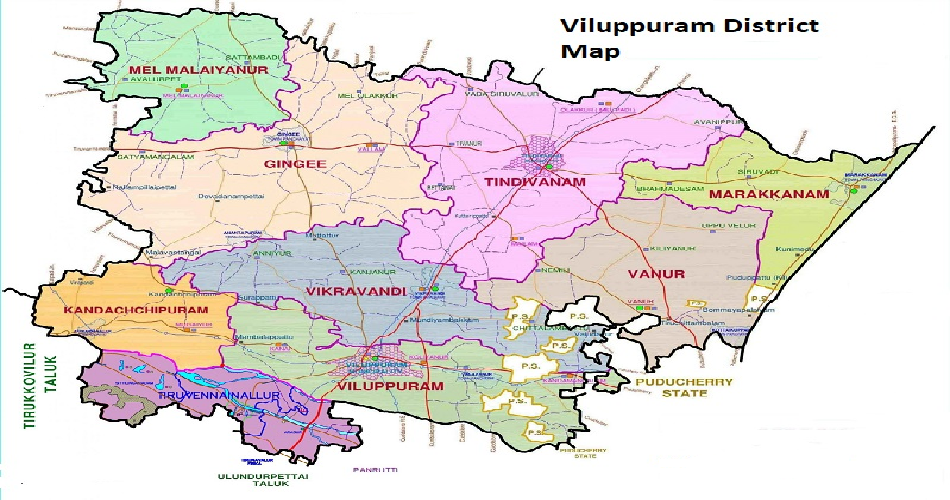
Villupuram, a vibrant district in Tamil Nadu, is a blend of historical grandeur, spiritual sanctity, and natural beauty. It’s an ideal destination for history buffs, spiritual seekers, and nature lovers.
Top Tourist Attractions (Must-Visit Destinations)
| Name of Place | Type | Key Highlights | Visitor Tip |
| Gingee Fort (Senji Fort) | Historical Fort | Often called the “Troy of the East.” Spans three hills: Rajagiri (highest), Krishnagiri, and Chandrayandurg. Features massive fortification walls, the Kalyana Mahal (Indo-Islamic architecture), Granaries, and the Venugopala Swamy Temple. Recently inscribed as a UNESCO World Heritage Site (as part of Maratha Military Landscapes). | Wear comfortable shoes, carry water, and start the climb early to beat the heat. The complex is large, requiring 3-4 hours to explore. Open 8:00 AM – 5:00 PM. |
| Auroville (The City of Dawn) | Experimental Township & Spiritual Site | The Matrimandir (the soul of Auroville, a golden sphere for silent contemplation) viewing point, Visitors Centre, Auroville Beach, and peaceful, eco-friendly green spaces. | You need to get a pass at the Visitors Centre to see the Matrimandir viewing point. The Matrimandir itself is for concentration/meditation and requires prior booking. It’s best visited as a day trip from Villupuram. |
| Thiruvakkarai Fossil Wood Park | Geological Park | India’s only national geological park featuring petrified tree trunks (fossilized wood) estimated to be over 20 million years old. The nearby Chandramouleeswarar Temple (dedicated to Lord Shiva) is also significant. | A fascinating spot for science and nature enthusiasts. Respect the ancient fossils and the park regulations. |
| Melmalayanur Angala Parameswari Temple | Temple / Pilgrimage | Highly revered temple dedicated to Goddess Angala Parameswari. Famous for its intense fire-walking festivals and the large congregation of devotees during New Moon rituals. | Visit on a New Moon day (Amavasai) for the most vibrant spiritual experience, though expect large crowds. |
| Mailam Murugan Temple | Hill Temple / Pilgrimage | Dedicated to Lord Muruga, located on a small hill near Tindivanam. Offers panoramic views of the surrounding plains. | A peaceful climb with a vibrant atmosphere, especially during the Panguni Uthiram festival (March/April). |
| Tirukoilur Ulagalantha Perumal Temple | Temple (Divya Desam) | One of the 108 Divya Desams (sacred Vishnu temples). Believed to be where Lord Vishnu took the Vamana (Ulagalantha) avatar. Massive and intricately carved structure on the banks of the River Pennaiyar. | A must-visit for devotees of Lord Vishnu (Vaishnavites) and admirers of grand temple architecture. |
| Kalrayan Hills | Nature / Eco-Tourism | Located on the Eastern Ghats, offering a refreshing escape with forested trails, tribal settlements, and scenic spots like the Periyar Falls and Mokkai Odai Waterfalls. | Ideal for eco-tourism, trekking, and nature photography. The climate is best after the monsoon. |
History & Culture Snapshot
- Ancient Heritage: Villupuram’s history is deeply intertwined with the ancient South Indian dynasties, including the Cholas, Pallavas, and Vijayanagara Kings.
- The Nayakas: The Gingee Fort was a key seat of power for the Nayaka rulers, under the Vijayanagar empire, and later came under the Marathas and the Mughals before falling to the French and then the British.
- Cultural Blend: The architecture in the district (e.g., Kalyana Mahal) reflects a blend of traditional South Indian styles with Indo-Islamic influences, showcasing its complex past.
Local Cuisine & Dining
Villupuram, like the rest of Tamil Nadu, offers rich and flavorful South Indian cuisine.
- Staple Foods: Look for traditional meals like Sambar, Rasam, and Kootu served with rice.
- Must-Try Breakfasts: Idli, Dosa, Pongal, and Vada are widely available and delicious.
- Local Delicacy: Don’t miss the local Chettinad or Madras-style Biryani, which is very popular in the region.
- Drinks: Tender coconut water, fresh fruit juices, and the local filter coffee (kaapi) are highly recommended.
Getting Around & Travel Tips
Best Time to Visit
- October to March: The weather is most pleasant, ranging from cool to mildly warm, making sightseeing and trekking comfortable.
- Avoid the peak summer months (April to June) when temperatures can be very high.
How to Reach Villupuram
| Mode of Transport | Details |
| By Air | The nearest airports are Chennai International Airport (MAA) (approx. 160 km) and Puducherry Airport (PNY) (approx. 40 km, limited connectivity). |
| By Rail | Villupuram Junction (VM) is a major railway junction connecting Chennai, Trichy, Madurai, and other parts of India. It is easily accessible from most southern and central Indian cities. |
| By Road | Villupuram is excellently connected by several National Highways (NH 32, NH 132, NH 38, etc.). State-run and private buses run frequently to and from Chennai, Puducherry, Trichy, and other major cities. |

Local Transport
- Auto-Rickshaws and Taxis: Easily available for travel within the city. Always agree on the fare before starting the journey.
- Buses: Local government buses are an economical way to travel between the main city and nearby towns or major attractions.
- Hiring a Car: For exploring the dispersed attractions like Gingee Fort, Auroville, and Kalrayan Hills, hiring a private car with a driver is the most convenient option.
Essential Visitor Tips
- Language: The primary language is Tamil. English is understood in tourist areas, major hotels, and railway/bus stations. Learning a few basic Tamil phrases (Vanakkam – Hello/Greetings) is appreciated.
- Dress Code: When visiting temples, it is mandatory to dress modestly. Shoulders and knees should be covered. Some temples may require men to remove their shirts before entering the inner sanctum.
- Water: Always drink bottled water or purified water.
- Currency: Indian Rupees (INR). ATMs are widely available in the main Villupuram city area.